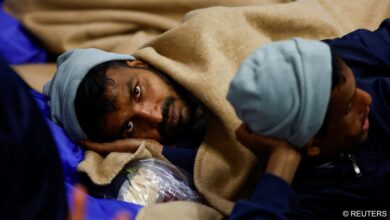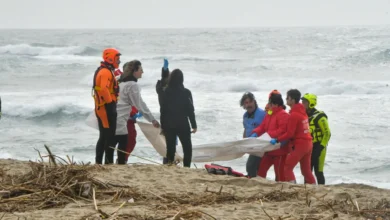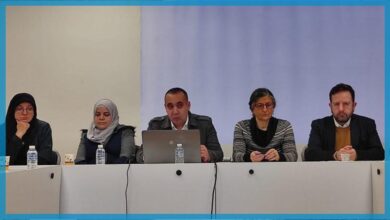Aylan Kurdi and Faris al-Ali… Through the eyes of the Turkish media
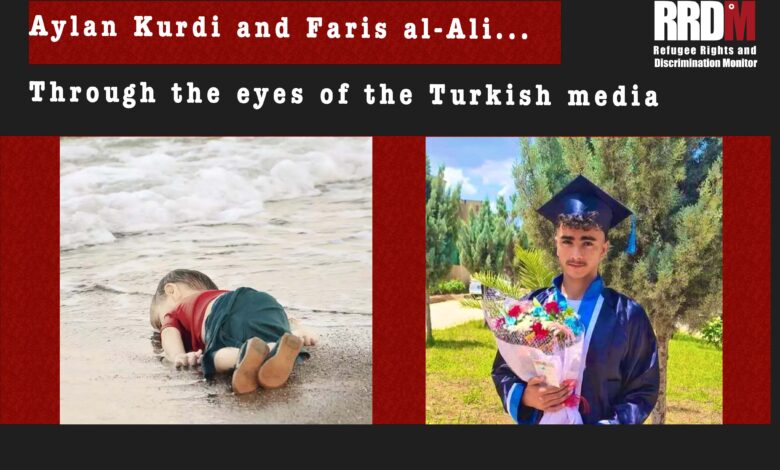
Dr. Fatma Türkkol
Introduction: News is a construction of meaning. Many “technical” details such as the chosen words, headlines, news sources, and the page on which the news appeared feeds a semantic map to the reader, indicating a particular point along with other similar or evocative topics. For this reason, the frequency with which words are used, how they identify the people who are the subject of the news, and the sources of the news are very important. This is why news texts were chosen as the basis for this article about a refugee story. Where do the details in the news lead us on the story we have learned as readers? How can discriminatory language, often used by those who express positive sensitivity towards refugees, be internalized on a mentally inseparable level? Do texts considered positive really offer the reader the expected level of approach?
So, what does the reader gain from knowing the answers to the questions listed? In the case of refugees, being part of the solution and taking positive steps is primarily about recognizing what the knowledge gained adds to the reader. Having the idea that an approach other than the designed meaning can also contribute to resolution can foster a dynamic and productive resolution process, while at the same time recognizing the thick misinformation about refugees is a huge asset.
For all these reasons, for this article, how is the story of a refugee told to the reader and “what can the reader understand from this news?” An attempt was made to create a frame containing the question.
A Tale of Two Children: This article is about two children. Unfortunately, we learned the names of these two children from the news of their deaths. The first is Aylan Kurdi. We met him in 2015. On September 2, 2015, he was a Syrian refugee boy who tried to cross with his family from Bodrum to Greece by boat. Three-year-old Aylan Kurdi, along with his mother and brother, drowned on this journey. His body was found on the beach with other refugees, while his photo was taken by reporter Nilüfer Demir and it appeared in the newspapers. The Bodrum High Criminal Court sentenced the arrested human smugglers to four years and two months in prison. On the other hand, Aylan Kurdi was buried with his mother and brother in Syria, his hometown, at the request of his father.
This small reminder is enough to bring the image of Aylan to our minds, despite the passage of seven years. The image, which is used frequently in both the Turkish and European press, has been the focus of discussions and assessments about refugees, at least for a while. For example, 46 news and columns about Aylan were published in Cumhuriyet newspaper in the six days following the incident. In Sabah newspaper, 21 news and columns in 11 days, and in Sözcü newspaper, 4 news and columns in 5 days, Aylan was mentioned.
Now let’s go back to 17-year-old Faris Muhammad Al-Ali, whom we met again on September 4, 2022, through news texts, to recall the contents of these news stories. Faris Muhammad, who lost his father in the war in Syria, came to Turkey as a refugee with his mother and siblings. Living in Hatay, Faris Mehmet Al-Ali completed his primary, secondary and high school education in Turkey. He continued his education in the educational campus opened by the NGO IHH in Hatay. He was able to get university admission in Balıkesir University Faculty of Medicine after passing the University Examination. A week before his death (ten days, according to some reports), a controversy took place in the tomato paste factory where he worked, involving Faris Muhammad. Fares Muhammad pushed or touched the woman who was the foreman during the argument, according to some news reports. But – according to the phrases in the news – he apologized to her, saying, “You are like my mother.” A week or ten days after the incident, Fares Muhammad was intercepted by a group of five people. First they beat him, then two people grabbed his arms and stabbed Faris Muhammad and ran away from the scene. Those around him called an ambulance, but the doctor in the ambulance found that Faris Muhammad Al-Ali was dead. He was buried in his hometown, Syria, at the request of his family.
The incident emerged for the first time in pictures recorded on social media, especially while waiting for an ambulance. News of the photos spread in a short time in the newspapers on September 4 and 5, 2022.
Before going into the details of the news, it might be appropriate to draw the general framework. When all the news is placed one under the other, they seem to focus on some issue.
* Faris Muhammad Al-Ali won the Faculty of Medicine.
* 17 years old.
*Describe the method of his death.
*Description of living conditions.
* Interpretations and implications regarding officials.
* The repercussions of why the event was not accepted.
The murder of Faris Muhammad al-Ali appeared in 13 stories published in 10 national newspapers in Turkey in two days. It turns out that most of the news headlines included information about his age, admission to medical school, and the cause of his death, and some of them indicated those responsible for the accident.
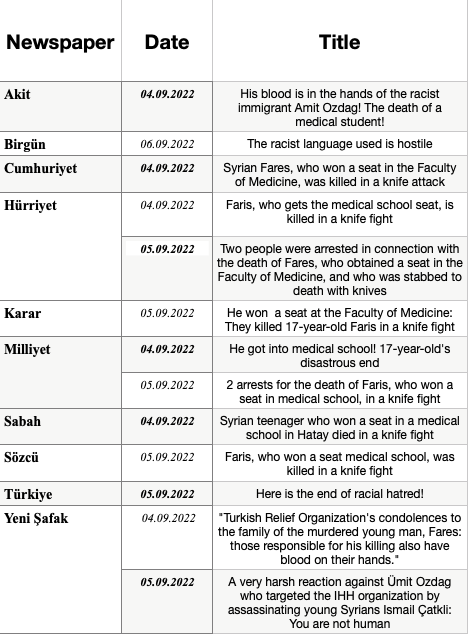
Let’s continue to recall the semantic structure of news along with news headlines. The meaning embedded in news texts is a world in which all the relationships of the institution that prepares the news and the dynamics of the society in which the news is presented are reflected in many sections. When we look at how the propositions in and around the news text support each other, it is seen that the relationship between time, situation, cause and effect is interconnected and coherent by referring to each other. Thus, what is previously known by concepts begins to reveal meaning. While describing the event that generated the text, information about it is also implied. Words and sentences refer to known “background” information. What is not actually said is said through allusions to key information. It finds its place in discourse with allusion, necessity, connotation, assumptions, and claims. For example, the fact that “illegal” in the news about refugees means something other than “breaking the law” is related to this. Because the mind to which the news is directed is not only limited to this, but also uploads past encounters to the text it saw last.
On this small basis, let’s take another look at the headlines about Faris Muhammad. The headlines make us realize how important the news event is: Faris Muhammad, a successful medical student.
With his success in the headlines, the difference of Faris, who was stabbed to death, is revealed from the “other” refugees, which is presented as an example in the debate about refugees at all levels in the country. The focus of social media, columns and news texts is complete with the mind that there are no refugees who are “non-working”, “failed”, “far from social integration”, “not deserving of humanitarian assistance”.
The fact that Faris Muhammad Al-Ali is 17 years old is also one of the highlights in the news texts. The murder of a young man with dreams at the beginning of his life, who is preparing to enroll in university, is in itself a devastating and unacceptable event. In the news about Fares Muhammad, a Syrian refugee, the situation is that he was a successful student, won medical school with “full marks in the YÖS exam,” worked in a tomato paste factory to “contribute financially” to his family, and right after arguing in the factory he said to the foreman: “You are like My mother,” and he apologized because he was “an orphan child whose father was a martyr.”
Immediately after this, there are descriptions of the manner in which he was killed. In detail, he states that he was beaten by five people, that some people grabbed his arms and the rest stabbed him, and that the people around him called an ambulance.
Is it possible to believe that the news is positive and that it gives clear statements about the killing of a child? The answer to this question is in the same headings. In 10 out of 13 stories and 6 headlines in 10 newspapers, it was reported that Faris Muhammad al-Ali died in a “knife fight”. However, news sources in the same news reported that the quarrel occurred a week ago, that on the day of his death he was beaten and held, and two people detained him, and the group fled from the scene after he was beaten and stabbed. However, the phrase “fighting”, specifically “knife fighting” in the news, is sufficient to present the Most High and the Group of Five as equal sides. The information that the attackers were arrested and taken to court was given in the last parts of the news and in all the newspapers with a written statement issued by the Hatay Governor’s Office: “In the incident that occurred last night in Narlika district in which a person lost his life. The perpetrators were arrested in short time and refer them to the judicial authorities.
In addition to all of this, the source of the news must be mentioned. The priority while preparing the news is the credibility of the source of the news. Credibility manifests itself in the acceptance of official authorities, politicians, and experts as news sources in practically the dominant media. The source, on the other hand, is very important because it frames and defines it. The source of the news, whose rights have been violated, who personally experienced the event, touching on the topic of the news, what changes and what is expected in daily life, can reach a quality that can be revealed through real subjects. The absence of refugees among those who expressed their views during the statements and discussions makes the denial of the above-mentioned racist rhetoric one-sided. It is important that the targets of hate speech are not among the sources of news, as it may also limit avenues for resolution.
More precisely, there is only one piece of news that includes the opinions of some refugee associations on this subject (Birgün, 06.09.2022). Apart from that, it is noted that 10 out of 13 news stories in 10 newspapers use the text prepared by the regional correspondent of the Dubai Health Authority.
Although there have been some headline changes, the news is quite the same. Bülent Yıldırım, head of the IHH Relief and Humanitarian Aid Foundation, is the main news source in the news. All details related to the incident were obtained from Yıldırım’s statements. While Yıldırım was visiting the family of Faris Mehmet Al-Ali, “Interior Minister Suleyman Soylu also called Yıldırım on his mobile phone” and expressed his condolences to Fares Hasun Al-Ali’s brother and his family, while the journalist who was there was covering the event. (Akit, Hürriyet, Karar, Milliyet 04.09.2022)
Who is the criminal? The sayings about the criminal in the news of Fares Muhammad should be mentioned in particular. Hate speech, which is widely expressed from politicians to social media users, which is constantly shared and circulated, occurs in most news texts as being responsible for the killing of refugees and especially Faris Muhammad Al-Ali. These hints are based (except for one) on the statements of IHH President Bulent Yildirim: “This child of ours died because of racist rhetoric. Let everyone think about the reason for that. The hands of those responsible are as bloody as the one that used this knife.” And “Because of this violent rhetoric, because of the unnecessary Mafia serials, this son of ours died
The hate language that entered the news texts with the phrase “racist rhetoric” in Yildirim’s statements is presented as the “murderer” of Fares Mehmet. “Senior figures spread racist rhetoric,” Yildirim said. While this sentence is in different newspapers, the politicians they refer to are different: “The head of the Zefer Party is Ümit Özdağ” (Yeni Şafak, 09.05.2022), “the language of ‘racism and hate’ used by the government, politicians and supporters-media (Bergun, 09.06.2022), “His blood is in the hands of the racist immigrant Umit Özdağ!” (Aket, 09.04.2022).
This approach means that they socially accept a passive, aggressive and exclusionary attitude towards refugees. However, after this point, the topic shifts from discrimination to politicians.
Intense Similarity Between Two News Phrases: We have only recently learned that Faris Mohammed Al-Ali passed away. However, we know the frame of the news we met with from 2015. The emphasis, allusions and presentation of the event in the news about Aylan Kurdi are quite similar. First of all, the way of death and age are in the foreground in both news. Similar words to Aylan Kurdi, such as “tiny body” and “baby”, are used for Faris Muhammed as “successful student”, “his dead body was taken to the morgue”. Also in the news about Aylan Kurdi, “The bitter father: he slipped through my hands”, “To whom am I going to get a banana now?” In the news about Faris Muhammed, statements such as “Because the children of martyrs and orphans care about their mothers.” is presented to the reader.
This language, which is closely related to the way the news is made about two children who died, brings the feeling of pity to the fore. This places the semantic basis of the news in a mutual positioning as two strong and weak sides. After this point, it becomes difficult to include an idea about a solution in the same news text. Because the intensity of emotion makes it more convenient to focus on the details of the event and the murderer, who is often singled out. Thus, every attack against refugees becomes isolated and detached from its social counterpart. As such, it becomes difficult for ideas to circulate about the need for a socially different approach to refugees. This process, which completes each other and continues in the form of a chain, of course does not start and end with the news texts containing the story of Faris Muhammed Al-Ali.
The seven years between the two news topics stands before us as an important example, reminding us that the cloud of meaning will remain the same as long as the approach to the news about refugees – as journalists and readers – does not differ.

